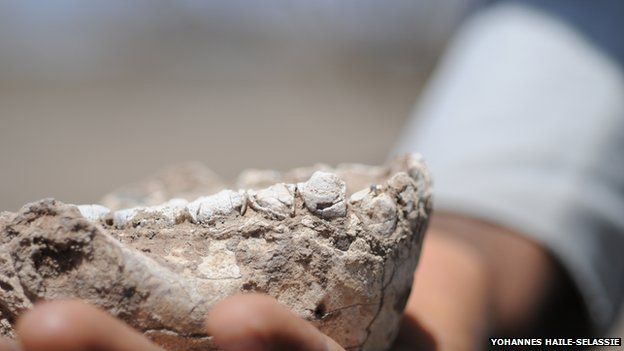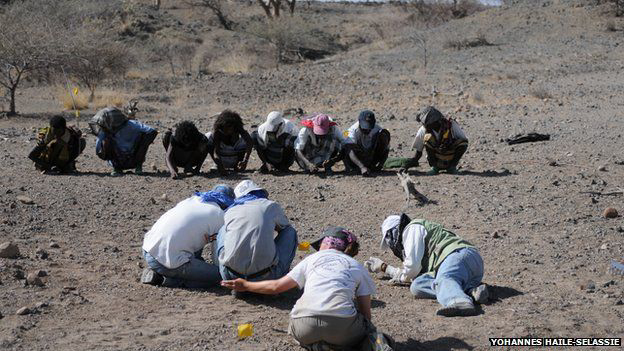


New species of ancient human discovered: reports on a new species of ancient human that has been unearthed in the Afar region of Ethiopia.

Image: Yohannes Haile-Selassie
A BBC News article by Science Correspondent Rebecca Morelle - 'New species' of ancient human found - reports on a new species of ancient human that has been unearthed in the Afar region of Ethiopia.

Image: Yohannes Haile-Selassie
Researchers have discovered jaw bones and teeth which date to between 3.3m and 3.5m years old, which indicates that this new hominin was alive at the same time as several other early human species. The new species has been called Australopithecus deyiremeda, which means 'close relative' in the language spoken by the Afar people. However, the discovery means the evolutionary tree is now more complicated rather than clearer.
The research has been published in the journal Nature:
New species from Ethiopia further expands Middle Pliocene hominin diversity
Yohannes Haile-Selassie et al
Nature 521, 483-488 (28 May 2015) doi:10.1038/nature 14448
The ancient fossils are thought to belong to four individuals, who according to lead researcher Dr Yohannes Haile-Selassie, curator of physical anthropology at the Cleveland Museum of Natural History in the United States, would have had both ape and human-like features.
By examining the teeth and jaws the researchers have found major differences. The new species has a very robust jaw and smaller teeth; different from the potentially three other species of early humans that were alive at this time.
The most famous of the 'group of four' is Australopithecus afarensis - Lucy - who lived between 2.9-3.8m years ago, initially thought to be our direct ancestor. But the discovery of another species Kenyanthropus platyops in Kenya in 2001, and Australopithecus bahrelghazali in Chad, and now the new species Australopithecus deyiremeda, suggests that there were several species co-existing; the title of 'direct ancestor' is proving more elusive.
In other words, the hypothesis of linear evolution has to be revisited; there are many species that could give rise to later hominins, including our own genus Homo. In order to clarify this, Dr Haile-Selassie is the first to admit that more fossils need to be unearthed, to better understand the path that human evolution took. He goes on to say that this discovery introduces another fascinating debate - if and how different species lived side-by-side. Did they mix or did they avoid each other?
Link to the ORIGINS section:
http://www.bradshawfoundation.com/origins/index.php
by Bradshaw Foundation
Tuesday 21 March 2023
by Bradshaw Foundation
Tuesday 07 February 2023
by Bradshaw Foundation
Thursday 19 May 2022
by Bradshaw Foundation
Tuesday 19 October 2021
by Bradshaw Foundation
Friday 25 June 2021
by Bradshaw Foundation
Monday 09 November 2020
by Bradshaw Foundation
Tuesday 03 November 2020
by Bradshaw Foundation
Wednesday 28 October 2020
by Bradshaw Foundation
Tuesday 23 June 2020
by Bradshaw Foundation
Thursday 04 June 2020
by Bradshaw Foundation
Thursday 14 May 2020
by Bradshaw Foundation
Tuesday 12 May 2020
by Bradshaw Foundation
Wednesday 19 February 2020
by Bradshaw Foundation
Tuesday 21 January 2020
by Bradshaw Foundation
Monday 20 January 2020
by Bradshaw Foundation
Thursday 28 November 2019
by Bradshaw Foundation
Tuesday 21 March 2023
by Bradshaw Foundation
Tuesday 07 February 2023
by Bradshaw Foundation
Thursday 19 May 2022
by Bradshaw Foundation
Tuesday 19 October 2021
by Bradshaw Foundation
Friday 25 June 2021
by Bradshaw Foundation
Monday 09 November 2020
by Bradshaw Foundation
Tuesday 03 November 2020
by Bradshaw Foundation
Wednesday 28 October 2020
by Bradshaw Foundation
Tuesday 23 June 2020
by Bradshaw Foundation
Thursday 04 June 2020
by Bradshaw Foundation
Thursday 14 May 2020
by Bradshaw Foundation
Tuesday 12 May 2020
by Bradshaw Foundation
Wednesday 19 February 2020
by Bradshaw Foundation
Tuesday 21 January 2020
by Bradshaw Foundation
Monday 20 January 2020
by Bradshaw Foundation
Thursday 28 November 2019
Friend of the Foundation











